Nursing Case Study: Comprehensive Analysis of Ulcerative Colitis
VerifiedAdded on 2023/04/21
|7
|1831
|54
Case Study
AI Summary
This nursing case study provides a detailed analysis of a patient, Eleanor, diagnosed with ulcerative colitis that has progressed to pancolitis. It explores the structural and functional changes associated with the condition, explaining Eleanor's symptoms such as weight loss, cramping, diarrhea, and abdominal pain. The case study discusses the administration of morphine for pain management and its mechanism of action on the nervous system. It also identifies key clinical manifestations of ulcerative colitis, including bloody diarrhea, weight loss, and abdominal discomfort. Furthermore, the study examines the use of prednisolone to reduce inflammation and suppress the immune system, detailing its effects on lymphocyte count and fluid balance. The analysis is supported by relevant references, providing a comprehensive overview of the nursing care and pharmacological interventions for ulcerative colitis. Desklib provides a platform for students to access similar solved assignments and study resources.
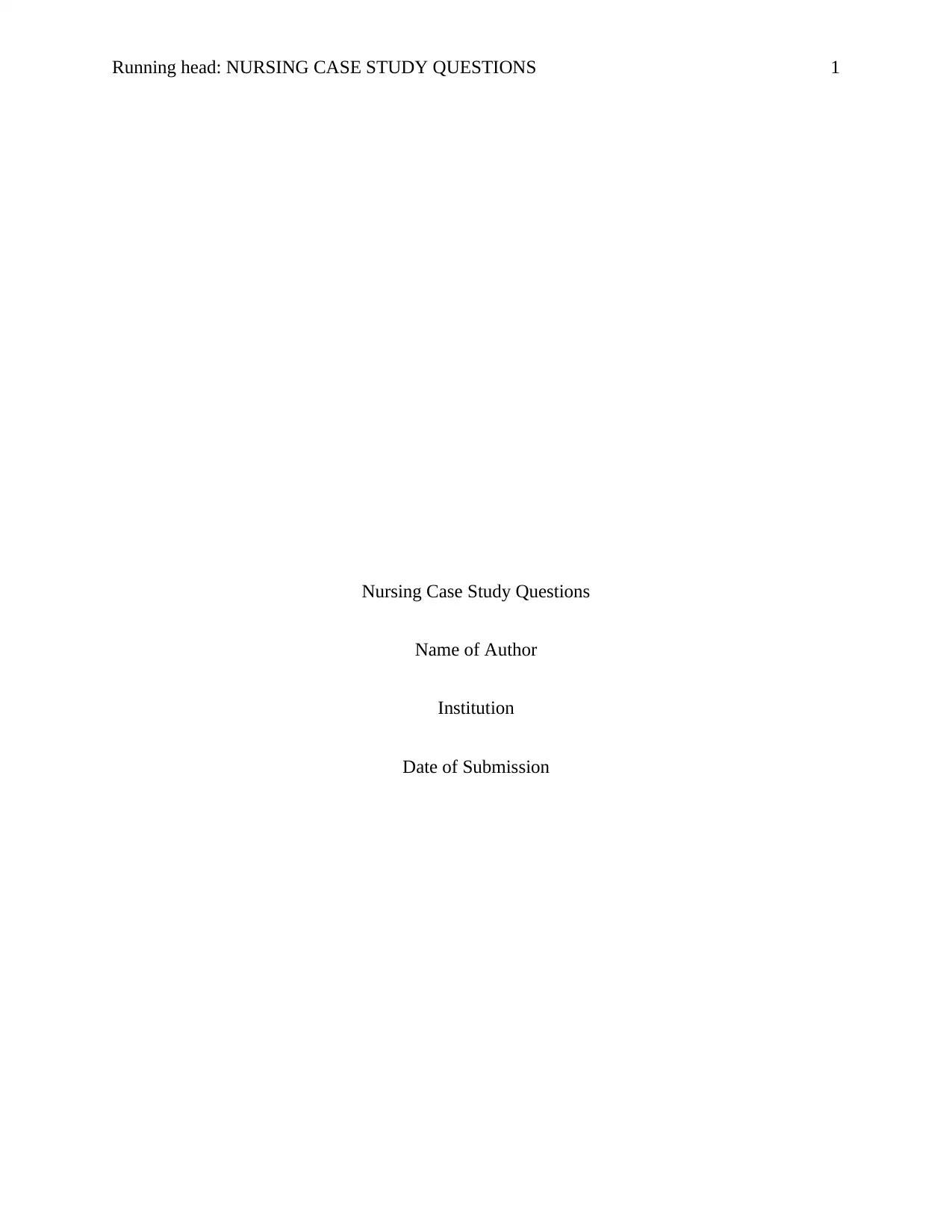
Running head: NURSING CASE STUDY QUESTIONS 1
Nursing Case Study Questions
Name of Author
Institution
Date of Submission
Nursing Case Study Questions
Name of Author
Institution
Date of Submission
Paraphrase This Document
Need a fresh take? Get an instant paraphrase of this document with our AI Paraphraser
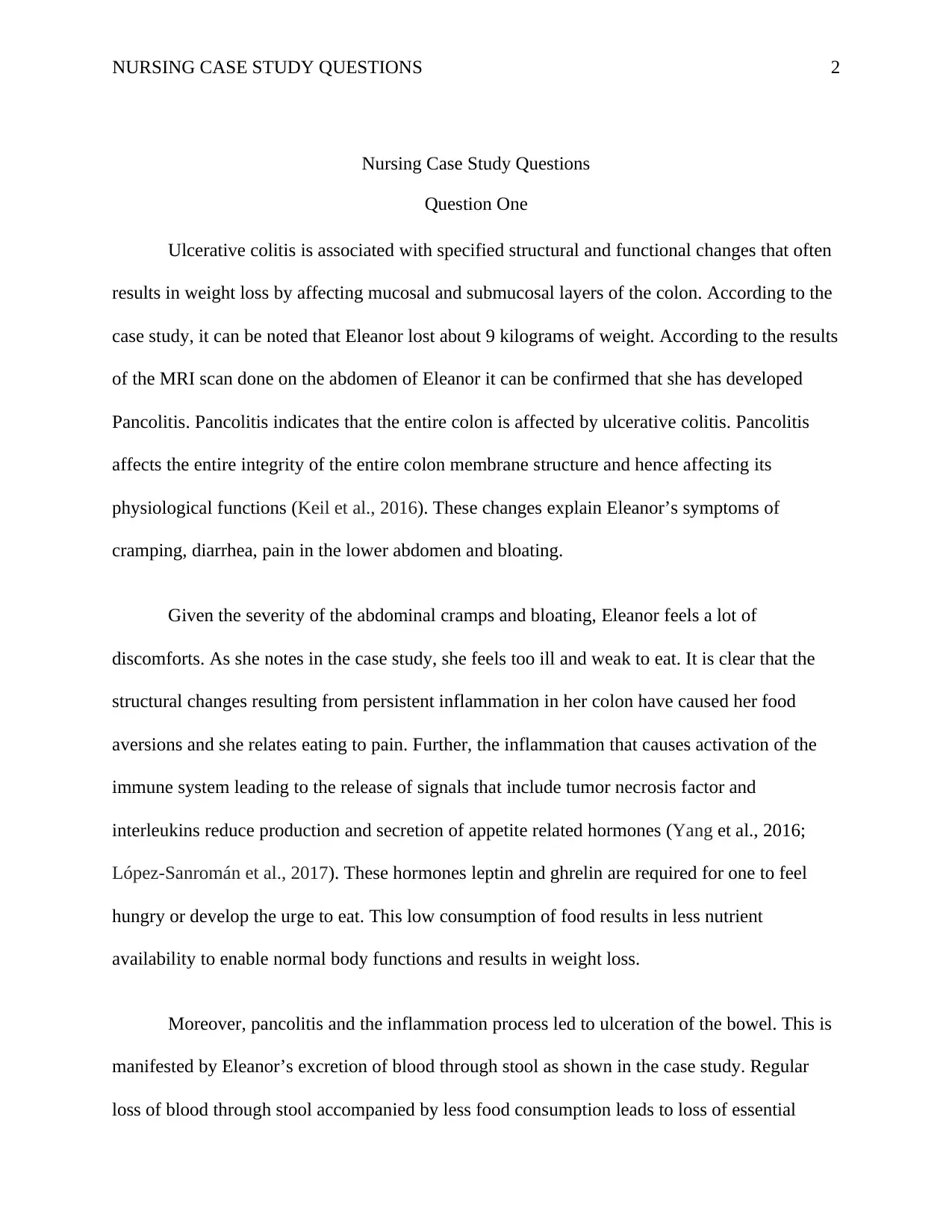
NURSING CASE STUDY QUESTIONS 2
Nursing Case Study Questions
Question One
Ulcerative colitis is associated with specified structural and functional changes that often
results in weight loss by affecting mucosal and submucosal layers of the colon. According to the
case study, it can be noted that Eleanor lost about 9 kilograms of weight. According to the results
of the MRI scan done on the abdomen of Eleanor it can be confirmed that she has developed
Pancolitis. Pancolitis indicates that the entire colon is affected by ulcerative colitis. Pancolitis
affects the entire integrity of the entire colon membrane structure and hence affecting its
physiological functions (Keil et al., 2016). These changes explain Eleanor’s symptoms of
cramping, diarrhea, pain in the lower abdomen and bloating.
Given the severity of the abdominal cramps and bloating, Eleanor feels a lot of
discomforts. As she notes in the case study, she feels too ill and weak to eat. It is clear that the
structural changes resulting from persistent inflammation in her colon have caused her food
aversions and she relates eating to pain. Further, the inflammation that causes activation of the
immune system leading to the release of signals that include tumor necrosis factor and
interleukins reduce production and secretion of appetite related hormones (Yang et al., 2016;
López-Sanromán et al., 2017). These hormones leptin and ghrelin are required for one to feel
hungry or develop the urge to eat. This low consumption of food results in less nutrient
availability to enable normal body functions and results in weight loss.
Moreover, pancolitis and the inflammation process led to ulceration of the bowel. This is
manifested by Eleanor’s excretion of blood through stool as shown in the case study. Regular
loss of blood through stool accompanied by less food consumption leads to loss of essential
Nursing Case Study Questions
Question One
Ulcerative colitis is associated with specified structural and functional changes that often
results in weight loss by affecting mucosal and submucosal layers of the colon. According to the
case study, it can be noted that Eleanor lost about 9 kilograms of weight. According to the results
of the MRI scan done on the abdomen of Eleanor it can be confirmed that she has developed
Pancolitis. Pancolitis indicates that the entire colon is affected by ulcerative colitis. Pancolitis
affects the entire integrity of the entire colon membrane structure and hence affecting its
physiological functions (Keil et al., 2016). These changes explain Eleanor’s symptoms of
cramping, diarrhea, pain in the lower abdomen and bloating.
Given the severity of the abdominal cramps and bloating, Eleanor feels a lot of
discomforts. As she notes in the case study, she feels too ill and weak to eat. It is clear that the
structural changes resulting from persistent inflammation in her colon have caused her food
aversions and she relates eating to pain. Further, the inflammation that causes activation of the
immune system leading to the release of signals that include tumor necrosis factor and
interleukins reduce production and secretion of appetite related hormones (Yang et al., 2016;
López-Sanromán et al., 2017). These hormones leptin and ghrelin are required for one to feel
hungry or develop the urge to eat. This low consumption of food results in less nutrient
availability to enable normal body functions and results in weight loss.
Moreover, pancolitis and the inflammation process led to ulceration of the bowel. This is
manifested by Eleanor’s excretion of blood through stool as shown in the case study. Regular
loss of blood through stool accompanied by less food consumption leads to loss of essential
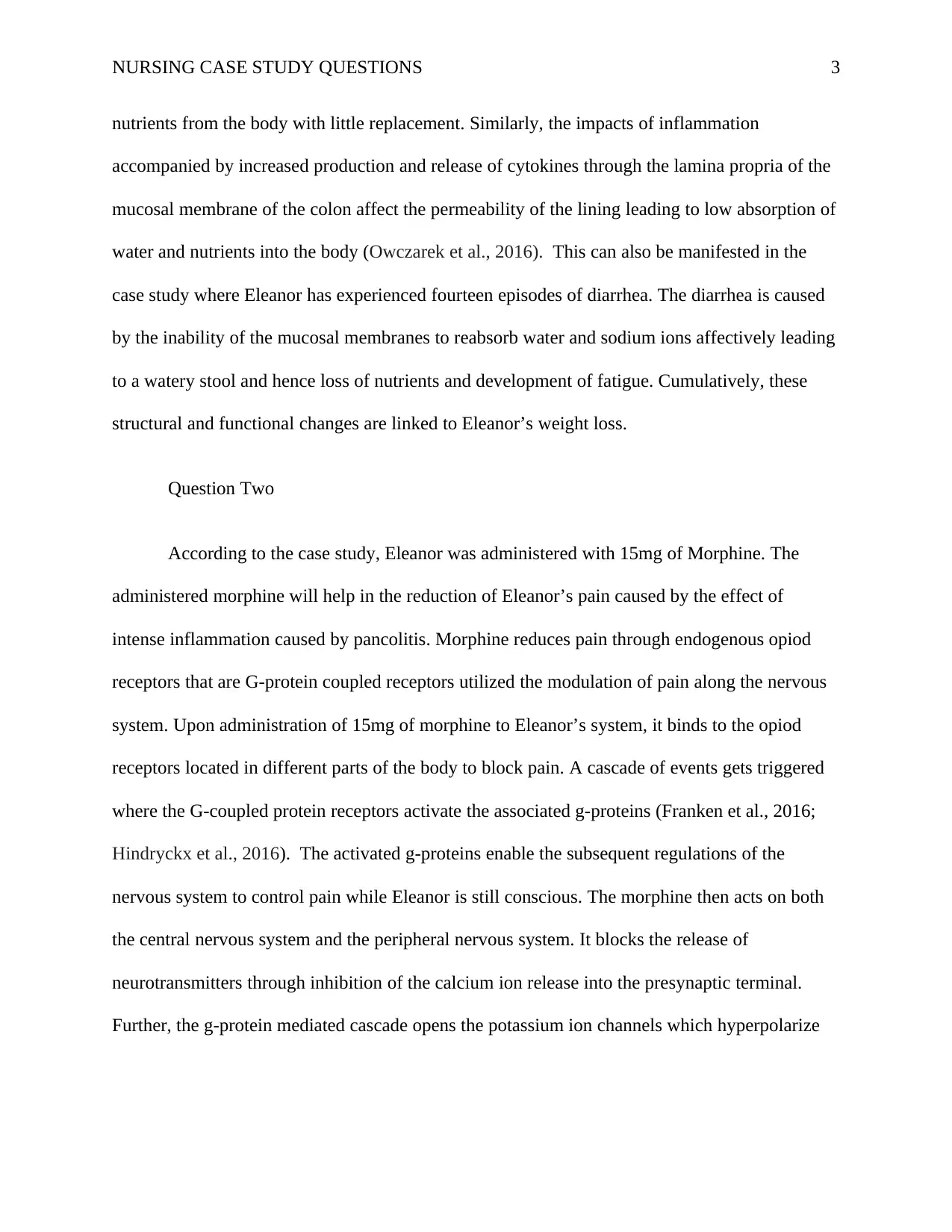
NURSING CASE STUDY QUESTIONS 3
nutrients from the body with little replacement. Similarly, the impacts of inflammation
accompanied by increased production and release of cytokines through the lamina propria of the
mucosal membrane of the colon affect the permeability of the lining leading to low absorption of
water and nutrients into the body (Owczarek et al., 2016). This can also be manifested in the
case study where Eleanor has experienced fourteen episodes of diarrhea. The diarrhea is caused
by the inability of the mucosal membranes to reabsorb water and sodium ions affectively leading
to a watery stool and hence loss of nutrients and development of fatigue. Cumulatively, these
structural and functional changes are linked to Eleanor’s weight loss.
Question Two
According to the case study, Eleanor was administered with 15mg of Morphine. The
administered morphine will help in the reduction of Eleanor’s pain caused by the effect of
intense inflammation caused by pancolitis. Morphine reduces pain through endogenous opiod
receptors that are G-protein coupled receptors utilized the modulation of pain along the nervous
system. Upon administration of 15mg of morphine to Eleanor’s system, it binds to the opiod
receptors located in different parts of the body to block pain. A cascade of events gets triggered
where the G-coupled protein receptors activate the associated g-proteins (Franken et al., 2016;
Hindryckx et al., 2016). The activated g-proteins enable the subsequent regulations of the
nervous system to control pain while Eleanor is still conscious. The morphine then acts on both
the central nervous system and the peripheral nervous system. It blocks the release of
neurotransmitters through inhibition of the calcium ion release into the presynaptic terminal.
Further, the g-protein mediated cascade opens the potassium ion channels which hyperpolarize
nutrients from the body with little replacement. Similarly, the impacts of inflammation
accompanied by increased production and release of cytokines through the lamina propria of the
mucosal membrane of the colon affect the permeability of the lining leading to low absorption of
water and nutrients into the body (Owczarek et al., 2016). This can also be manifested in the
case study where Eleanor has experienced fourteen episodes of diarrhea. The diarrhea is caused
by the inability of the mucosal membranes to reabsorb water and sodium ions affectively leading
to a watery stool and hence loss of nutrients and development of fatigue. Cumulatively, these
structural and functional changes are linked to Eleanor’s weight loss.
Question Two
According to the case study, Eleanor was administered with 15mg of Morphine. The
administered morphine will help in the reduction of Eleanor’s pain caused by the effect of
intense inflammation caused by pancolitis. Morphine reduces pain through endogenous opiod
receptors that are G-protein coupled receptors utilized the modulation of pain along the nervous
system. Upon administration of 15mg of morphine to Eleanor’s system, it binds to the opiod
receptors located in different parts of the body to block pain. A cascade of events gets triggered
where the G-coupled protein receptors activate the associated g-proteins (Franken et al., 2016;
Hindryckx et al., 2016). The activated g-proteins enable the subsequent regulations of the
nervous system to control pain while Eleanor is still conscious. The morphine then acts on both
the central nervous system and the peripheral nervous system. It blocks the release of
neurotransmitters through inhibition of the calcium ion release into the presynaptic terminal.
Further, the g-protein mediated cascade opens the potassium ion channels which hyperpolarize
⊘ This is a preview!⊘
Do you want full access?
Subscribe today to unlock all pages.

Trusted by 1+ million students worldwide
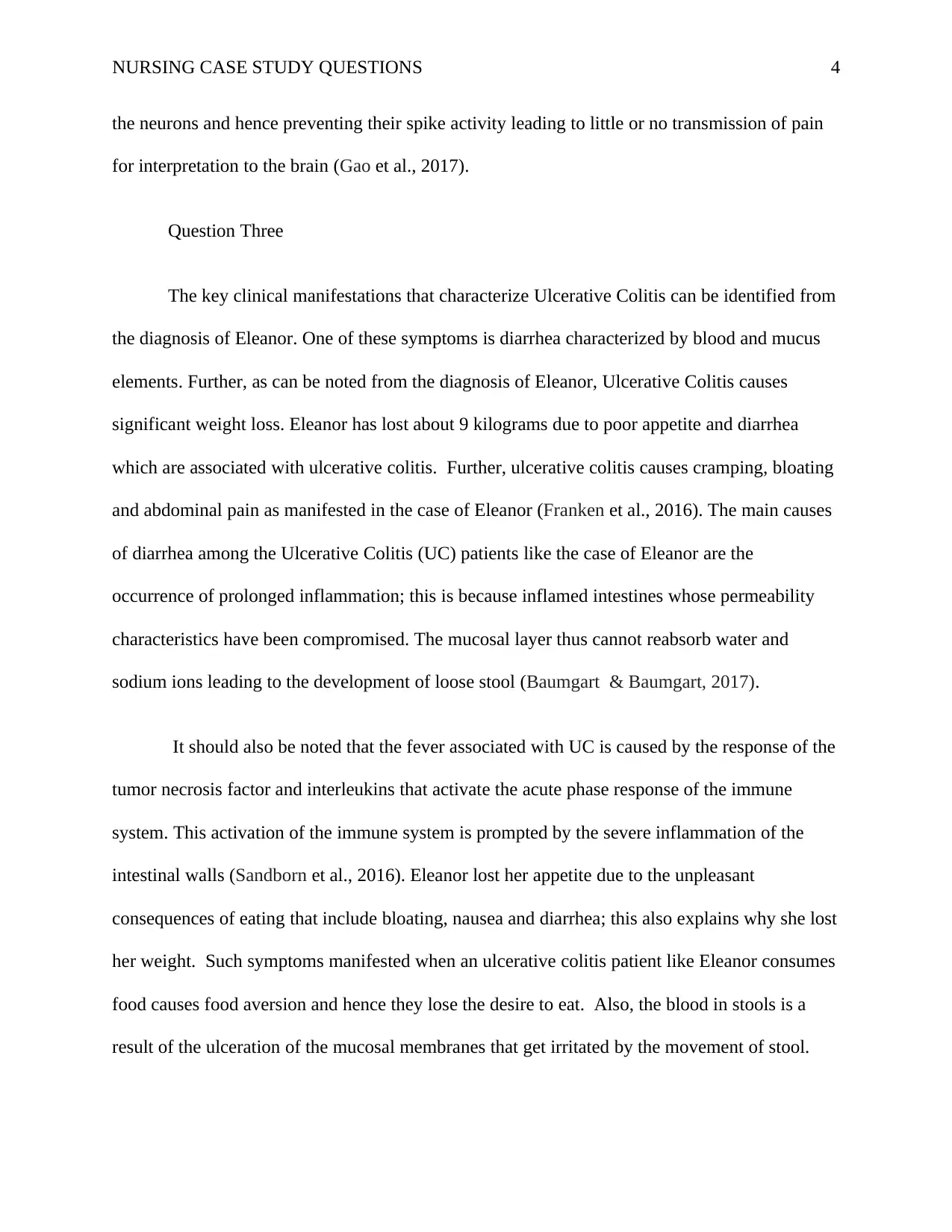
NURSING CASE STUDY QUESTIONS 4
the neurons and hence preventing their spike activity leading to little or no transmission of pain
for interpretation to the brain (Gao et al., 2017).
Question Three
The key clinical manifestations that characterize Ulcerative Colitis can be identified from
the diagnosis of Eleanor. One of these symptoms is diarrhea characterized by blood and mucus
elements. Further, as can be noted from the diagnosis of Eleanor, Ulcerative Colitis causes
significant weight loss. Eleanor has lost about 9 kilograms due to poor appetite and diarrhea
which are associated with ulcerative colitis. Further, ulcerative colitis causes cramping, bloating
and abdominal pain as manifested in the case of Eleanor (Franken et al., 2016). The main causes
of diarrhea among the Ulcerative Colitis (UC) patients like the case of Eleanor are the
occurrence of prolonged inflammation; this is because inflamed intestines whose permeability
characteristics have been compromised. The mucosal layer thus cannot reabsorb water and
sodium ions leading to the development of loose stool (Baumgart & Baumgart, 2017).
It should also be noted that the fever associated with UC is caused by the response of the
tumor necrosis factor and interleukins that activate the acute phase response of the immune
system. This activation of the immune system is prompted by the severe inflammation of the
intestinal walls (Sandborn et al., 2016). Eleanor lost her appetite due to the unpleasant
consequences of eating that include bloating, nausea and diarrhea; this also explains why she lost
her weight. Such symptoms manifested when an ulcerative colitis patient like Eleanor consumes
food causes food aversion and hence they lose the desire to eat. Also, the blood in stools is a
result of the ulceration of the mucosal membranes that get irritated by the movement of stool.
the neurons and hence preventing their spike activity leading to little or no transmission of pain
for interpretation to the brain (Gao et al., 2017).
Question Three
The key clinical manifestations that characterize Ulcerative Colitis can be identified from
the diagnosis of Eleanor. One of these symptoms is diarrhea characterized by blood and mucus
elements. Further, as can be noted from the diagnosis of Eleanor, Ulcerative Colitis causes
significant weight loss. Eleanor has lost about 9 kilograms due to poor appetite and diarrhea
which are associated with ulcerative colitis. Further, ulcerative colitis causes cramping, bloating
and abdominal pain as manifested in the case of Eleanor (Franken et al., 2016). The main causes
of diarrhea among the Ulcerative Colitis (UC) patients like the case of Eleanor are the
occurrence of prolonged inflammation; this is because inflamed intestines whose permeability
characteristics have been compromised. The mucosal layer thus cannot reabsorb water and
sodium ions leading to the development of loose stool (Baumgart & Baumgart, 2017).
It should also be noted that the fever associated with UC is caused by the response of the
tumor necrosis factor and interleukins that activate the acute phase response of the immune
system. This activation of the immune system is prompted by the severe inflammation of the
intestinal walls (Sandborn et al., 2016). Eleanor lost her appetite due to the unpleasant
consequences of eating that include bloating, nausea and diarrhea; this also explains why she lost
her weight. Such symptoms manifested when an ulcerative colitis patient like Eleanor consumes
food causes food aversion and hence they lose the desire to eat. Also, the blood in stools is a
result of the ulceration of the mucosal membranes that get irritated by the movement of stool.
Paraphrase This Document
Need a fresh take? Get an instant paraphrase of this document with our AI Paraphraser
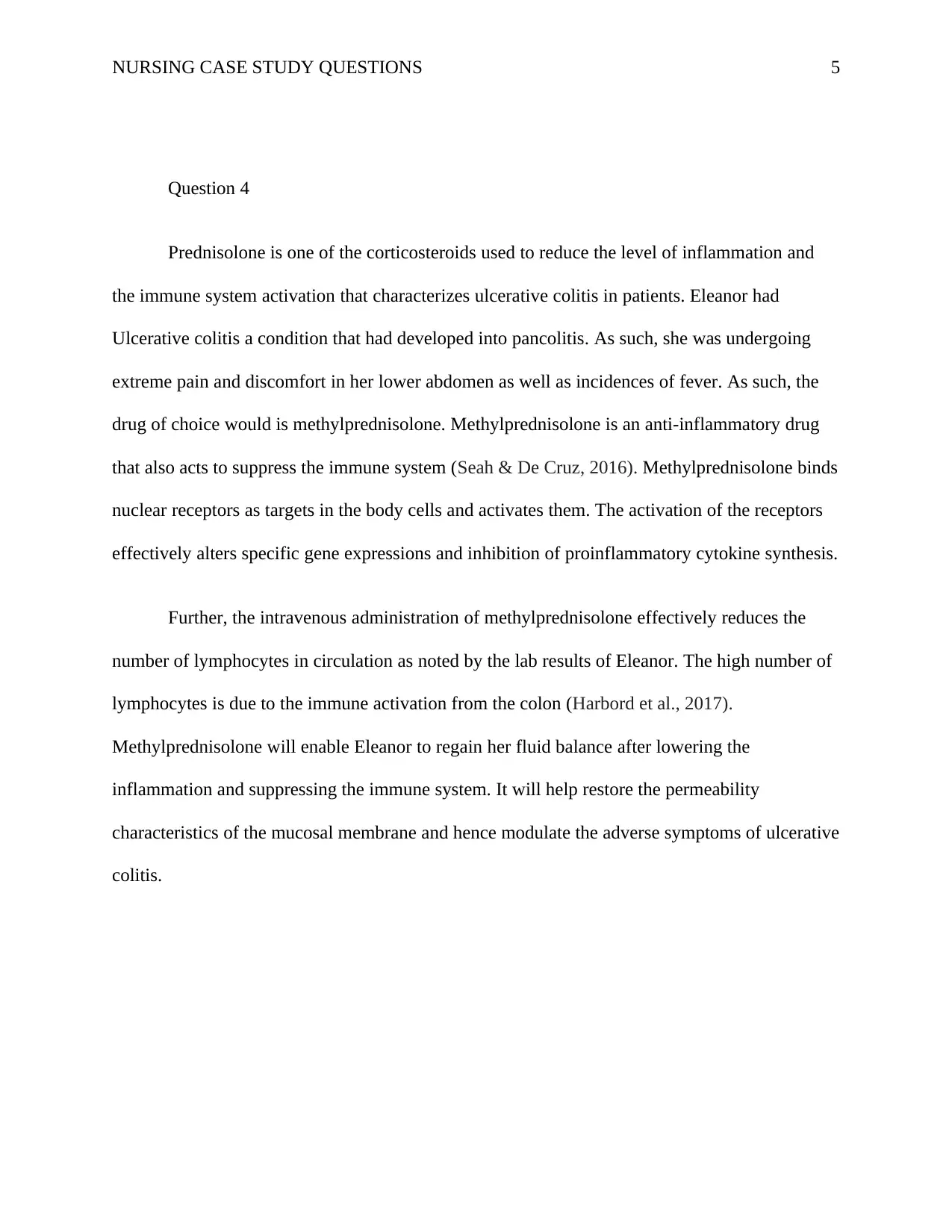
NURSING CASE STUDY QUESTIONS 5
Question 4
Prednisolone is one of the corticosteroids used to reduce the level of inflammation and
the immune system activation that characterizes ulcerative colitis in patients. Eleanor had
Ulcerative colitis a condition that had developed into pancolitis. As such, she was undergoing
extreme pain and discomfort in her lower abdomen as well as incidences of fever. As such, the
drug of choice would is methylprednisolone. Methylprednisolone is an anti-inflammatory drug
that also acts to suppress the immune system (Seah & De Cruz, 2016). Methylprednisolone binds
nuclear receptors as targets in the body cells and activates them. The activation of the receptors
effectively alters specific gene expressions and inhibition of proinflammatory cytokine synthesis.
Further, the intravenous administration of methylprednisolone effectively reduces the
number of lymphocytes in circulation as noted by the lab results of Eleanor. The high number of
lymphocytes is due to the immune activation from the colon (Harbord et al., 2017).
Methylprednisolone will enable Eleanor to regain her fluid balance after lowering the
inflammation and suppressing the immune system. It will help restore the permeability
characteristics of the mucosal membrane and hence modulate the adverse symptoms of ulcerative
colitis.
Question 4
Prednisolone is one of the corticosteroids used to reduce the level of inflammation and
the immune system activation that characterizes ulcerative colitis in patients. Eleanor had
Ulcerative colitis a condition that had developed into pancolitis. As such, she was undergoing
extreme pain and discomfort in her lower abdomen as well as incidences of fever. As such, the
drug of choice would is methylprednisolone. Methylprednisolone is an anti-inflammatory drug
that also acts to suppress the immune system (Seah & De Cruz, 2016). Methylprednisolone binds
nuclear receptors as targets in the body cells and activates them. The activation of the receptors
effectively alters specific gene expressions and inhibition of proinflammatory cytokine synthesis.
Further, the intravenous administration of methylprednisolone effectively reduces the
number of lymphocytes in circulation as noted by the lab results of Eleanor. The high number of
lymphocytes is due to the immune activation from the colon (Harbord et al., 2017).
Methylprednisolone will enable Eleanor to regain her fluid balance after lowering the
inflammation and suppressing the immune system. It will help restore the permeability
characteristics of the mucosal membrane and hence modulate the adverse symptoms of ulcerative
colitis.
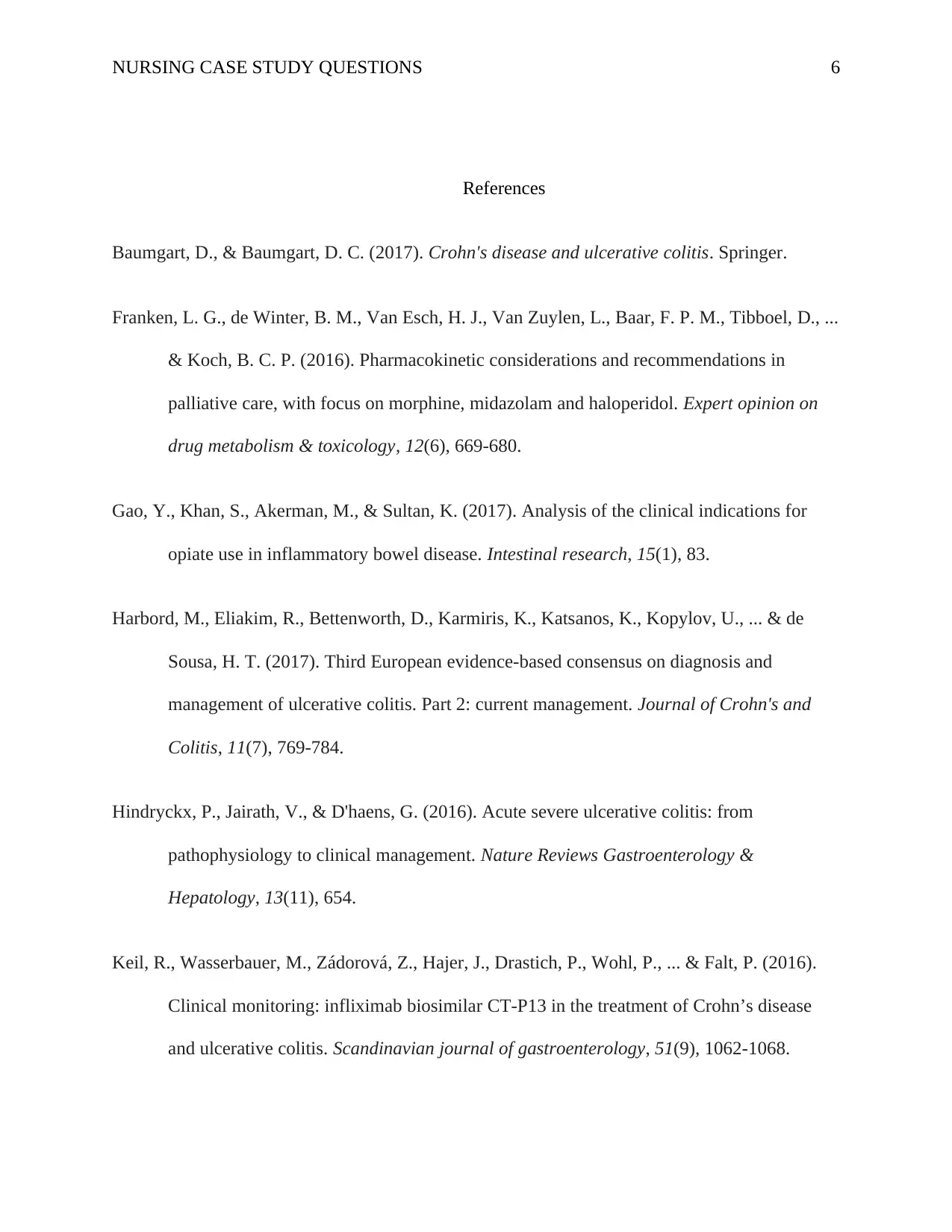
NURSING CASE STUDY QUESTIONS 6
References
Baumgart, D., & Baumgart, D. C. (2017). Crohn's disease and ulcerative colitis. Springer.
Franken, L. G., de Winter, B. M., Van Esch, H. J., Van Zuylen, L., Baar, F. P. M., Tibboel, D., ...
& Koch, B. C. P. (2016). Pharmacokinetic considerations and recommendations in
palliative care, with focus on morphine, midazolam and haloperidol. Expert opinion on
drug metabolism & toxicology, 12(6), 669-680.
Gao, Y., Khan, S., Akerman, M., & Sultan, K. (2017). Analysis of the clinical indications for
opiate use in inflammatory bowel disease. Intestinal research, 15(1), 83.
Harbord, M., Eliakim, R., Bettenworth, D., Karmiris, K., Katsanos, K., Kopylov, U., ... & de
Sousa, H. T. (2017). Third European evidence-based consensus on diagnosis and
management of ulcerative colitis. Part 2: current management. Journal of Crohn's and
Colitis, 11(7), 769-784.
Hindryckx, P., Jairath, V., & D'haens, G. (2016). Acute severe ulcerative colitis: from
pathophysiology to clinical management. Nature Reviews Gastroenterology &
Hepatology, 13(11), 654.
Keil, R., Wasserbauer, M., Zádorová, Z., Hajer, J., Drastich, P., Wohl, P., ... & Falt, P. (2016).
Clinical monitoring: infliximab biosimilar CT-P13 in the treatment of Crohn’s disease
and ulcerative colitis. Scandinavian journal of gastroenterology, 51(9), 1062-1068.
References
Baumgart, D., & Baumgart, D. C. (2017). Crohn's disease and ulcerative colitis. Springer.
Franken, L. G., de Winter, B. M., Van Esch, H. J., Van Zuylen, L., Baar, F. P. M., Tibboel, D., ...
& Koch, B. C. P. (2016). Pharmacokinetic considerations and recommendations in
palliative care, with focus on morphine, midazolam and haloperidol. Expert opinion on
drug metabolism & toxicology, 12(6), 669-680.
Gao, Y., Khan, S., Akerman, M., & Sultan, K. (2017). Analysis of the clinical indications for
opiate use in inflammatory bowel disease. Intestinal research, 15(1), 83.
Harbord, M., Eliakim, R., Bettenworth, D., Karmiris, K., Katsanos, K., Kopylov, U., ... & de
Sousa, H. T. (2017). Third European evidence-based consensus on diagnosis and
management of ulcerative colitis. Part 2: current management. Journal of Crohn's and
Colitis, 11(7), 769-784.
Hindryckx, P., Jairath, V., & D'haens, G. (2016). Acute severe ulcerative colitis: from
pathophysiology to clinical management. Nature Reviews Gastroenterology &
Hepatology, 13(11), 654.
Keil, R., Wasserbauer, M., Zádorová, Z., Hajer, J., Drastich, P., Wohl, P., ... & Falt, P. (2016).
Clinical monitoring: infliximab biosimilar CT-P13 in the treatment of Crohn’s disease
and ulcerative colitis. Scandinavian journal of gastroenterology, 51(9), 1062-1068.
⊘ This is a preview!⊘
Do you want full access?
Subscribe today to unlock all pages.

Trusted by 1+ million students worldwide
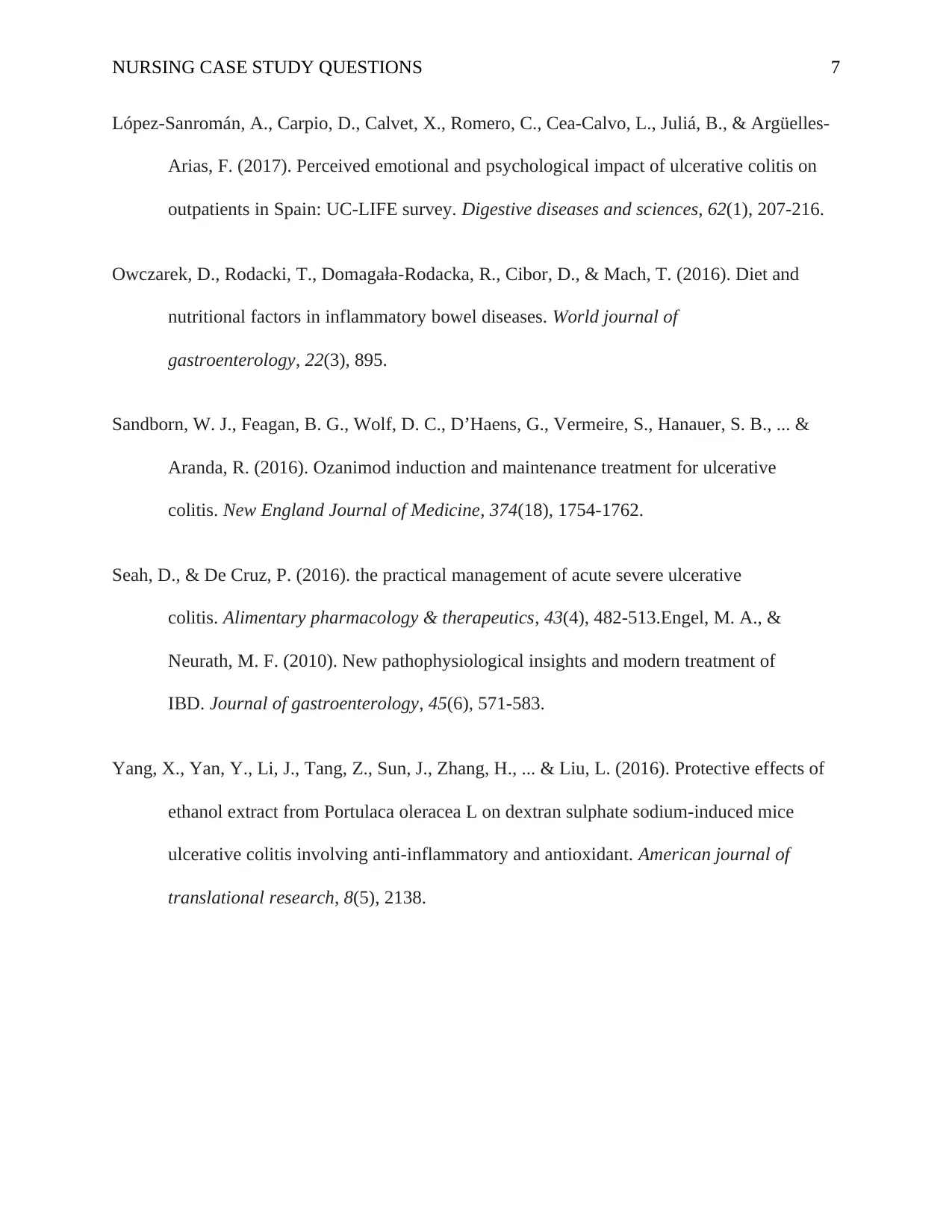
NURSING CASE STUDY QUESTIONS 7
López-Sanromán, A., Carpio, D., Calvet, X., Romero, C., Cea-Calvo, L., Juliá, B., & Argüelles-
Arias, F. (2017). Perceived emotional and psychological impact of ulcerative colitis on
outpatients in Spain: UC-LIFE survey. Digestive diseases and sciences, 62(1), 207-216.
Owczarek, D., Rodacki, T., Domagała-Rodacka, R., Cibor, D., & Mach, T. (2016). Diet and
nutritional factors in inflammatory bowel diseases. World journal of
gastroenterology, 22(3), 895.
Sandborn, W. J., Feagan, B. G., Wolf, D. C., D’Haens, G., Vermeire, S., Hanauer, S. B., ... &
Aranda, R. (2016). Ozanimod induction and maintenance treatment for ulcerative
colitis. New England Journal of Medicine, 374(18), 1754-1762.
Seah, D., & De Cruz, P. (2016). the practical management of acute severe ulcerative
colitis. Alimentary pharmacology & therapeutics, 43(4), 482-513.Engel, M. A., &
Neurath, M. F. (2010). New pathophysiological insights and modern treatment of
IBD. Journal of gastroenterology, 45(6), 571-583.
Yang, X., Yan, Y., Li, J., Tang, Z., Sun, J., Zhang, H., ... & Liu, L. (2016). Protective effects of
ethanol extract from Portulaca oleracea L on dextran sulphate sodium-induced mice
ulcerative colitis involving anti-inflammatory and antioxidant. American journal of
translational research, 8(5), 2138.
López-Sanromán, A., Carpio, D., Calvet, X., Romero, C., Cea-Calvo, L., Juliá, B., & Argüelles-
Arias, F. (2017). Perceived emotional and psychological impact of ulcerative colitis on
outpatients in Spain: UC-LIFE survey. Digestive diseases and sciences, 62(1), 207-216.
Owczarek, D., Rodacki, T., Domagała-Rodacka, R., Cibor, D., & Mach, T. (2016). Diet and
nutritional factors in inflammatory bowel diseases. World journal of
gastroenterology, 22(3), 895.
Sandborn, W. J., Feagan, B. G., Wolf, D. C., D’Haens, G., Vermeire, S., Hanauer, S. B., ... &
Aranda, R. (2016). Ozanimod induction and maintenance treatment for ulcerative
colitis. New England Journal of Medicine, 374(18), 1754-1762.
Seah, D., & De Cruz, P. (2016). the practical management of acute severe ulcerative
colitis. Alimentary pharmacology & therapeutics, 43(4), 482-513.Engel, M. A., &
Neurath, M. F. (2010). New pathophysiological insights and modern treatment of
IBD. Journal of gastroenterology, 45(6), 571-583.
Yang, X., Yan, Y., Li, J., Tang, Z., Sun, J., Zhang, H., ... & Liu, L. (2016). Protective effects of
ethanol extract from Portulaca oleracea L on dextran sulphate sodium-induced mice
ulcerative colitis involving anti-inflammatory and antioxidant. American journal of
translational research, 8(5), 2138.
1 out of 7
Related Documents
Your All-in-One AI-Powered Toolkit for Academic Success.
+13062052269
info@desklib.com
Available 24*7 on WhatsApp / Email
![[object Object]](/_next/static/media/star-bottom.7253800d.svg)
Unlock your academic potential
Copyright © 2020–2025 A2Z Services. All Rights Reserved. Developed and managed by ZUCOL.



